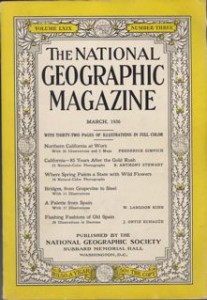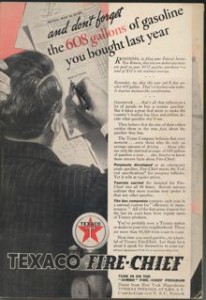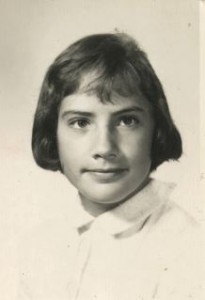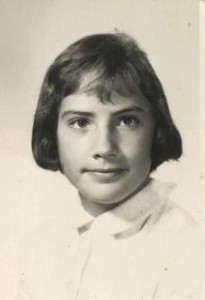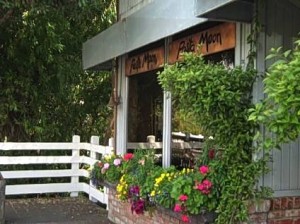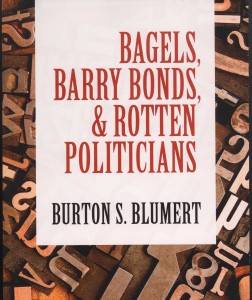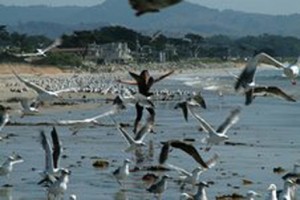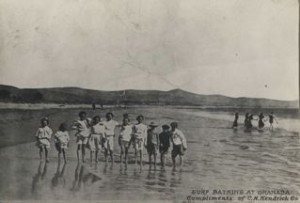 [Image: San Francisco developer Charles Kendrick used this photograph to publicize Granada as a new place to live.]
[Image: San Francisco developer Charles Kendrick used this photograph to publicize Granada as a new place to live.]
El Granada’s Jim Elliott: Honored as one of the Country’s Finest “Finish” Carpenters
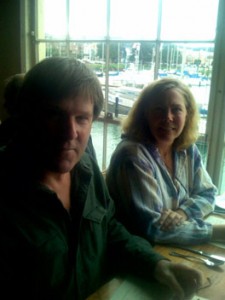 [Jim Elliott and Carole Delmar earlier this year.]
[Jim Elliott and Carole Delmar earlier this year.]
Congratulations Jim!
Wife and Coastside realtor Carole Delmar says: Jim was picked for the top 17 finish carpenters in the Unites States to participate in a De Walt tool contest. He won lots of tools and now has 2 months to submit a project. His head can hardly fit through the front door! But he is in a very good mood and we like that!
What’s a finish carpenter, please click here
1936: National Geographic Covered Northern California
The Stories Inside:
Northern California at Work
California – 85 years after the Gold Rush
Where Spring paints a State with Wild Flowers
Bridges, from Grapevine to Steel
A Palette from Spain
Flashing Fashions of Old Spain
One image was shot by famous Bay Area photographer Gabriel Moulin. You’ll have to imagine the photo because I cannot reproduce it here. The caption reads: Roses climb to the very tip of a Redwood at La Honda, San Mateo County. Rich in scenic charm, ingratiating in climate, these wooded valleys are set with many country homes of San Franciscans. Known locally as “the Peninsula,” this region is famed for its cut flowers and fine vegetables, including artichokes. Over motor highways and on suburban trains commuters pour in and out of San Francisco.
The advertisement on the back of the 1936 magazine reads:
Individual Income Tax return….and don’t forget the 608 gallons of gasoline you bought last year
Remember in filing your Federal Income Tax Return, that you can deduct any taxes you paid on your 1935 gasoline purchases–a total of $32 is the national average.
Remember, too, that this year you’ll buy another 608 gallons. That’s a business-size order. It deserves business-like consideration.
Guesswork….that’s what influences a lot of people to buy a certain gasoline. But it takes a great deal more to make the country’s leading bus lines and airlines decide what gasoline “they’ll” use.
They believe that the size of their orders entitles them to the true “facts” about the gasoline they buy.
The Texas Company believes that “every” motorist…even those who do only an average amount of driving….those who use only the national average of 608 gallons of gasoline a year….also deserves to know these sincere facts about Fire-Chief.
Purposely developed as an emergency grade gasoline, Fire-Chief meets the Federal specifications* for “emergency” vehicles. Yet it sells at “regular” prices.
Tourists carried the demand for Fire-Chief into all 48 states. Recent surveys indicate that more tourists now prefer it than other gasoline.
The bus companies compete each year in a national contest for “efficiency in maintenance.” All of the first-prize winners for the last six years have been regular users of Texaco products.
You’ve probably seen a Texaco station or dealer in your very neighborhood. There are more than 40,000 from coast to coast.
Next time you need gasoline, try a tankful of Texaco Fire-Chief. Let these facts about it speak for themselves in your car.
*Federal Specification VV-M-571 for Emergency Motor Fuel
Texaco Fire-Chief
Tune in on the “Jumbo” Fire-Chief Program
Direct from New York Hippodrome
Tuesday Evenings at 9:30 EST
Coast-to-Coast N.B.C. Network
——
No Country For Old Men: Separated at Birth?
Is this a match?
That’s me wearing the Prince Valiant “do,” circa what was then called junior high. And next to me is Javier Bardem, the gorgeous star of “No Country for Old Men.”
Pretty Pasta Moon on Main Street
Coast Highway Race, 1951: Short Story by Erich von Neff
Coast Highway Race, 1951
Story by Erich von Neff
All of us, I’m sure, have, at one time or another, cursed or blessed the coastal wind. Constantly and incessantly it blows down the coast, though driving in a car it is no more than an annoyance. But jog or ride a bike along Highway One, at certain times of the day, and it is almost as if you are in a wind tunnel. Barely able to run or budge the pedals, or being accelerated at rocket speed, depending on which way you are going.
In early March of 1951 – in preparation for the real races to be held on Murphy Sabatino’s board track in San Jose – we began a race in Half Moon Bay.
The race, as usual, started in front of Pete’s Café on Main Street in Half Moon Bay. Chevy’s and Fords rolled up, their engines backfired and sputtered to a stop. Trainers and coaches began to unload bicycles. One could hear the swish, swish of air pumps, the clanking of cleats, and curses when something was amiss with the equipment.
Pete did a brisk business in undiluted black coffee. We strained the grounds with our teeth; we set our cups down, we asked for refills.
Soon riders began to assemble at the starting line. Bruce Svihus the Norwegian who lived at the Henrik Ibsen Park carried his bike to the line without tires. If credence can be lent to his story: In a drunken fury, Hans Larsen, a merchant seaman, had somehow shredded Bruce’s tires. He must have possessed brute Viking-like strength to have done this without a knife. However, there would be no redress, for Hans had sailed that morning. Sven Rognerude who, like Bruce, was a member of the Norsk Sykell Klubb, pulled two weather beaten tires out of the trunk of his car.
Bruce and Sven mounted the tires, gluing them on with road glue. This was a sacrilege as everyone knew. One raced with track tires cemented on with orange shellac. Done in layers this process took a week. But it was the right way.
Hopefully, some rituals can be dispensed with in an emergency, though one should be wary when breaking with traditions.
Soon Bruce’s chrome plated D.B.S. track bike was ready. A marque that, as I understand it, little Norwegian girls made innuendoes about; giggling when they did so.*
Cycling like any sport has its trade-offs. Ride against a headwind, or on hills too often, and your legs lose suppleness for the track. Yet, of course, you need strength. Balance is the key. We would be riding with a tailwind and over hills with reasonable grades. Steeper hills, with headwinds too, had been ridden with heavier tires in training earlier in the year.
Pete and some of his clientele lined up to watch the start of the race. Men in sombreros drank scalding coffee. Some of them wagered among themselves.
We went off by classes: In groups of novice, Class C, B and A. The reason for these groupings was that all of these classes, would, hopefully, arrive at the finish line at approximately the same time…rather than run a separate race for each class.
The effect of such handicapping being that each group would work together trying to stay away or to assimilate the handicapped group(s) ahead.
Lido fired his gun in the air. Novice, Class C, B, and A were sent off at five minute intervals, separated by shots from Lido’s revolver.
Bang. Bang. Bang. Bang.
On the fourth pistol shot we were away.
Men beneath sombreros finished their coffee, then walked back inside Pete’s Café. We immediately formed a pace line, and began to rotate pace.
We rolled down Main Street and onto Highway One. Already men were working in the fields. A few of them waved to us. Had they been racers in Mexico, Brazil, or Argentina?
Proper etiquette, if it can be called that, dictated that we ride a synchronized pace line – no break- a- ways until class A caught all the groups ahead, then dropping most of them a few miles from the finish line in Santa Cruz. Those of us who were pluggers would, then, ceremoniously lead out the sprinters (almost always Sicilians or Italians) who would then contest the sprint among themselves.
This rationale we never questioned. We rolled on, our high pressure silk tires resonating against the asphalt. The pack becoming a force and life of its own. For a while all went well.
We came barreling down the hill toward Tinitus Creek. Short brisk turns were taken at the front. Suddenly Oscar Juner let out an oath in German. I could see his front tire flattening. He pulled over to the side of the pace line. The valve began thumping against the asphalt. The tire began to disintegrate and was torn off the wooden rim which now collapsed. Oscar’s bicycle skidded sideways, his pedal sending off a shower of sparks. No one looked back, following cars would take care of him.
The pace, though, had slackened slightly. Vince and Gus Gatto shouted something in Italian. This was followed by Fred Fisk bellowing in Norwegian. One of the Italians banged on the handlebars of a rider who had just finished his turn at the front, and was no drifting back to the rear of the pace line. Those taking their turn at the front got the message, the pace began to quicken.
Down and up the undulating hills, at times we could see and hear the ocean. At times we raced away from it. At all times accelerated by the coastal wind.
There were more flat tires, but none so disastrous. We carried no spares, or pumps, or water bottles. Why upset the purity of line of a track bike? A flat simply meant that one was not fated to finish that day. This — perhaps a sing of the times – we simply accepted. In any case, it was no disgrace., and besides, following cars took care of those left by the pack.
Finally, near Durigano’s Nursery in Pescadero we could see Class B ahead. Though no one knew it, the Norwegians had begun to conspire among themselves. Suddenly they – Fred Fisk, Bruce Suihus, Sven Rognerude, Max Starr, and some I do not now remember – formed a group alongside the pack. Their ringleader, Fred Fisk had let down the hammer and had ordered the others to follow. At first they were barely able to hang onto his wheel, but soon caught their breath and began to rotate pace.
This for most of us was worse than a sacrilege. It was mutiny. They would have to be taught a lesson.
I was, therefore, surprised to feel the pace slacken. Gus Gatto sat up in the saddle, looking around. He said something to his brother, Vince, which was in turn, communicated to the Sicilians and the Italians. The gap between the pack and the Norwegians widened.
At this moment, Lido’s Duesenberg drove up. The chauffeur kept abreast of the pack. Lido leaned out of the window, conferring with Gus. Gus nodded. The pace slowed some more.
The Norwegians had by now caught Class B. We were really in a pickle. Still the pace slackened.
Lido yelled something to the driver and to Antonio, the heavy set man sitting next to him. Lido and Antonio reached out the window each with a bottle in his hand. One was handed to the first rider, and so on. The other bottle started about the middle of the pace line; the first bottle would be consumed by then.
The bottle was passed back to me. Curious, I looked at the label: Fonseca’s Brandy, made in Half Moon Bay. I hadn’t heard of it; but this was no time to be finicky. I took a few swigs. Wham. Was this white lighting or what? Quickly enough I passed it back to the next rider. Thanks to Lido, other bottles of Fonseca’s Brandy were passed down the pace line. Transformed by this substance we shortly resumed our former speed, … plus. Our cranks turned even more reves as we accelerated and were reaccelerated by Fonseca’s Brandy and the coastal wind.
Thoughtlessly, the empty bottles were thrown in the brush; we knew nothing about ecology. Perhaps some day a bottle collector will come uon them, though by then our race will surely have been forgotten. This, however, is no more than a hope.
Lido kept a close eye on our progress, by having the chauffeur drive back and forth between the Norwegian and B group, then shouting the difference in time to us. At first we were two minutes down, gradually we edged up to one minute down.
Until Class B caught Class C and novice. Though many of these riders could not stay with the pack. Those that remained were to give us trouble.
Lido warned us from the Duesenberg that we were staying at one minute down. But, by now Fonseca’s Brandy was totally assimilated in our veins, and there was no stopping us, though some riders were blown off the back of the pace line.
Around Davenport we were upon them. Soon we were passing them Italians and Sicilians shook their fists and swore at the Norwegians. They would eat our dust.
Still there was no let up … until we approached the last mile when we began setting up for the sprint. Which in the course of things was predominantly a Sicilian affair, though the Italians did their best.
The pack fanned out into three groups. Because it is sometimes best to throw in with the probable visitors I and the rest of the San Francisco Wheelmen latched onto the Sicilian “train,” pulling for the Gatto brothers. The Italians were pulling for Harry Guidi. The Belmont Bicycle Club, the Deutsches Velo Klub and others pulling for Peter Rich.
Lido had been driven ahead. He sat in a director’s chair near the finish line, flanked by Sicilians, the brims of their hats turned down.
Bang! Lido fired his revolver in the air as we surged across the finish line. Not surprisingly, Gus Gatto won, followed by his brother Vince. Harry Guidi, an Italian, took third. The Deutsches Velo Klub had pulled their man, Peter Rich, to fourth place. And, as a reward for giving “their man” a lead out, I was pushed by an anonymous Sicilian for fifth place.
If Lido had observed this “indiscretion” he had said nothing.
Lido and his entourage now left. He never waited for losers. Those who were not loyal deserved an even worse fate. But he did not mete it out, at least not on that day.
Although it was of no consequence whatsoever Jack Casey, a fiery Irishman, won the field sprint of the combined novice C and B pack.
Other riders straggled in, finally in last place came Bruce Suihus arriving with a spasm in his right leg, from a cramp duly deserved.
The following cars now took us back to Pete’s Café in Half Moon Bay.
Laughter could be heard as we drank Acme, Rainer Ale, and Anchor Steam. Lido sat in the corner smoking his cigar and playing poker with his cronies. He had his arm around the waist of a blonde, who occasionally threw her head back and laughed at a joke he had just made.
Pete collected the money in a cigar box. Some had been foolish enough to bet against Gus. Lido nodded, and Pete went up to Bruce.
“Here, you take last place, maybe still you gotta get something.”
Pete handed Bruce a bottle of Fonseca’s Brandy and a corkscrew. Bruce pulled out the cork and went to take a swig, but it was empty.
Lido, the blonde, and the others at the poker table began to laugh, and so did many of the rest of us.
Bruce it must be said, took it in good humor, especially since Pete now handed him a full bottle.
“Be glad you’re not Sicilian kid,” Lido said. “I don’t like wise guys who get out of line. You gotta understand. Some things, they gotta be.”
Soon the real races would begin on Murphy Sabatino’s board track in San Jose. There would be no coastal wind. And, most often, all would go according to plan.
—-
John Vonderlin Looks Forward to the Golf Tournament…But his reason will surprise you
To read John Vonderlin’s story, please click here
Email John [email protected])
Watch the World Indices
For the numbers in Asia, Europe, please click here
You might think that economics isn’t for you but you may get hooked on these podcasts.
“The Trouble with Fractional Reserve Banking. Lew Rockwell interviews Doug French, Las Vegas economist/banker on the financial crisis.”
To listen, please click here
My Partner Burt Blumert’s New Book
For more information, please click here
Burton Blumert is an entrepeneur who knows not only all that there is to know about precious metals but also about politics and economics. He offers his wide-ranging insights in this funny, charming, and also learned collection of essays from many years of writing.
Email Burt: ([email protected])
Maria Demarest: The Birds II at El Granada Beach
Image by photographer Maria Demarest, who, while visiting Half Moon Bay last week, caught this spectacular scene at El Granada beach. One of the birds looks a little large. Is that Maria flying with the birds? Some things never change, thank goodness.
10/19/2008: I’ve been thinking about Maria’s photo. Wouldn’t it make fantastic wallpaper?

